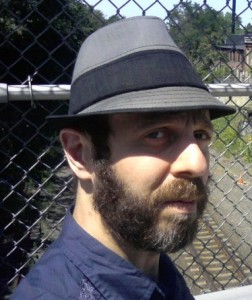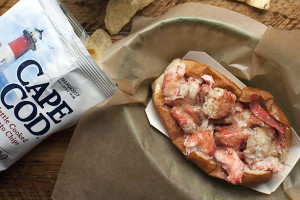Talking Cocktails with 'Drink & Tell''s Frederic Yarm
In 2006, Frederic Yarm was casually experimenting with cocktails from old Trader Vic’s guides and books like the Official Mixer’s Manual by famed New York bartender, Patrick Duffy. Then his wife encouraged him to visit Kenmore Square stalwart Eastern Standard. Now he’s Frederic Yarm: blogger, cocktail historian, distiller of esoteric bitters, and published writer of Drink & Tell: A Boston Cocktail Book, a local cocktail compendium which was published earlier this month. I recently sat down with Yarm to discuss the current landscape of all things mixology, including: which neighborhoods to plan around a bar crawl, where Boston stacks up against New York, and the unsung heroes of the local industry. —by Christopher Hughes
Is there a bartender or establishment that hasn’t gotten the press they deserve?
Estragon, with Sahil Mehta. He’s not there every night, but he does a lot of the work on the cocktail menu. It’s just the way he thinks about drinks from a culinary aspect; what kind of elements are in liqueurs or spirits which he could use to compliment other ingredients. There’s also Trina’s Starlite Lounge, which is doing good work with a sense of humor.
Are there any good rules you’ve learned for finding the next great bar?
It’s treating every staff member that you can with respect. They begin to know who you are. There are definitely some people who have won me over that work for bars I wasn’t even considering going to. Todd Maul [bar manager at Clio] I met at a Appleton Rum event at Green Street and I got an appreciation for what he’s interested in. That’s how you find out about the new up-and-coming places.
Are there any new trends in the mixology scene that people should be aware of?
Quirky things like room-temperature cocktails. They were being done in the 19th century. You can find them at Deep Ellum, Rendezvous and No.9 Park. To do it well, you have to be on! When you serve things on the rocks you can get dilution that causes sweetness to go away, but bitterness to go up. Cold numbs your tongue, and it can hide a lot of faults.
Is there anything besides technique or quality of ingredients that can spoil a drink?
Great drinks can be ruined by perception. There’s cocktails I’m turned off by or embarrassed by because the ingredients don’t jibe with the name.
I love the name of the cocktail you recently posted based on a James Thurber quote.
Yes, The Damp Hands of Melancholy by [local writer] Luke O’Neil and Daren Swisher (at Park). A good number of drinks have been named by me, actually. I’ll go to bars and ask what they’re tinkering with and I’ll put a name in brackets as a placeholder, so I don’t have to call it Eastern Standard #10 or something. It’s funny, now there’s a stock phrase where bartenders will tell me, ‘I’ll know what’s it’s called when I read it in your blog.’
Is there one name you’ve bestowed that you’re really proud of?
L’Esprit de L’Escalier for Kevin Martin (at Eastern Standard). It means: staircase wit. It’s for when you think of a great thing to say after you’ve already departed and you can’t get that jab in.
What are some tricks that people can employ at home when they’re on a tight budget?
Beer is great for cocktails. We do an [online] event called “Mixology Monday” for the blog and the theme one month was, “When Your 401k Becomes a 1k.” We took champagne cocktails and I substituted Heineken Light, which somebody had left at my house. Heineken is like a buck a can, and two of them are about the equivalent of a $10 bottle of prosecco or a $15 bottle of blanc de blancs. It’s dry and crisp and worked great with lemon and citrus. We also did similar things with Miller High Life.
How did the Boston cocktail scene get to where it is today?
Peer pressure. If you want to trace it back you can simplify it the B-Side Lounge (which closed its doors in 2008). A lot of bartenders were trained there and broke off to work at Eastern Standard and Barbara Lynch’s No. 9 Park. Then those places trained Andy McNees at Green Street [ed. note: now at Toro] and the list goes on and on. People are learning to be teachers and to teach better.
What are the neighborhoods that have the best concentration of bars for a high class bar crawl?
There are definitely three epicenters. Kenmore has five good bars for cocktails: Eastern Standard, Island Creek Oyster Bar, The Hawthorne, Citizen Public House and Clio. There’s Central Square, which has four good establishments: Brick & Mortar, Green Street, Rendezvous, and Craigie on Main. Also Downtown Crossing and Park Street. It has No. 9 Park, Stoddard’s, JM Curley, and Silvertone.
How do you think Boston stacks up against great cocktail towns like New York?
All of Boston could fit into one neighborhood in New York. There are more good bars in lower Manhattan than there is in all of Boston, Somerville and Cambridge. You’re allowed to be much edgier there. Boston has to be somewhere in the middle, because they have to appeal to an assortment of people. Look at the Yelp reviews for Brick & Mortar, where people are complaining, saying a third of the drinks have absinthe in them. Some people adore it, but generally those kind of drinks are not good introduction drinks.
Do you ever take a break from cocktails and order a beer?
My prejudice against beer and wine is that when you go to the store or the restaurant and a bottle is opened, the history is already written. Somebody already developed it. The person serving or selling it to you might not know the story. You’re so far removed from the brewer or vintner. When you get a cocktail you can ask how they came up with that combination of flavors, the name, how they tinkered with it. You’re so much closer to the story, the artistry, the process. .
For more online food coverage, find us on Twitter at @ChowderBoston.




